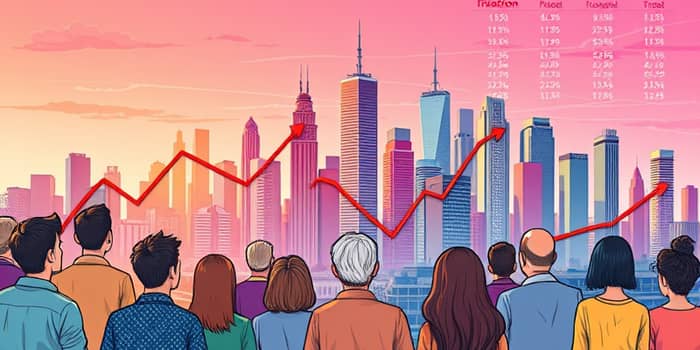
In an ever-evolving global economy, understanding inflation is more than observing price tags—it’s about anticipating tomorrow’s challenges and seizing opportunities. This in-depth exploration will guide you through the current landscape, reveal the forces at work, and equip you with practical strategies to navigate a world of shifting costs.
As of May 2025, the U.S. annual inflation rate has climbed to approximately 2.5%, up from 2.3% in April. Contrary to earlier forecasts predicting a slowdown, many economists now anticipate a persistent climb through the year. Core PCE inflation, which excludes volatile food and energy sectors, is hovering around 2.8% and may even approach 3% if external pressures intensify.
Those figures might seem abstract, but they shape the everyday decisions of consumers, businesses, and policymakers. A modest rise in core inflation can ripple across wages, borrowing costs, and investor sentiment—affecting everything from grocery bills to mortgage rates.
The trajectory of inflation is influenced by a complex web of factors that can accelerate or restrain price growth. Understanding these elements helps you anticipate changes and adjust your financial plans with confidence.
Consumer spending power is directly eroded by rising prices. A recent poll found 77% of Americans believe their incomes aren’t keeping pace with inflation. When grocery bills, rent, and utility costs climb faster than wages, households must make tough choices—prioritizing essentials or dipping into savings.
Businesses face their own set of challenges. Input costs for raw materials and labor can surge, squeezing profit margins. Companies that fail to adapt by improving efficiency, renegotiating supplier contracts, or passing on a portion of costs risk reduced competitiveness.
Inflation doesn’t hit every sector equally. By examining projected price changes, you can tailor your strategies for budgeting, investing, and planning.
Whether you’re an individual budgeting for your family or a business leader steering a company through uncertain times, adopting resilient purchasing strategies will help maintain stability and even unlock new opportunities.
Central banks, particularly the Federal Reserve, play a central role in steering inflation toward targeted levels—typically around 2%. Through tools like interest rate adjustments and quantitative easing, policymakers aim to balance growth and price stability. However, their decisions rely on timely data and accurate forecasts, meaning unexpected shocks can complicate the path to equilibrium.
Fiscal policies—such as infrastructure spending, tax credits, and direct financial support—also influence demand. When governments inject capital into the economy or cut taxes, consumer spending tends to increase, potentially stoking inflation if production fails to keep pace.
Predicting inflation is inherently uncertain. Several factors could tilt the scales in either direction:
As we advance through 2025 and beyond, staying informed and agile will be crucial. Monitor reliable economic indicators—PCE data releases, producer price indexes, and labor market reports—to gauge turning points in price trends. Engage with financial professionals to align your investment, saving, and spending plans with evolving conditions.
Inflation is often framed as a challenge, but it can also serve as a catalyst for innovation and resilience. By adopting proactive financial planning measures and continuously refining your strategy, you can transform rising prices from a threat into an opportunity for growth.
Remember: knowledge is power. Equip yourself with rigorous economic insights and flexible tactics. Cultivate a network of trusted advisors and stay curious about emerging trends. In doing so, you’ll not only weather the next inflationary wave but also build a foundation for long-term prosperity.
References













